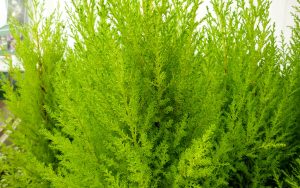Menu
If you caught our recent video, you’ll know that there is a conifer for every location and every season. Whether you are going for all-round greenery or splashes of colour, for height or ground cover, there will be a variety to suit you.
The beauty of conifers is also that they need very little care and attention; once established, you can usually leave them to ‘do their thing’. So, you might ask, why have we even written about how to care for them? There are a few basics that it is helpful to know, so here is our short guide.

Conifers are a family of trees and shrubs which have leaves shaped like needles or scales. They carry their seeds in cones, or sometimes fruit, and the majority are evergreen (they keep their leaves all year). They also have a wide range of barks that can provide added interest. Fossil evidence suggests that conifers as a species are over 300 million years old, originating in the colder climes of Europe and North America, but now native in higher latitude tropics, such as China and Borneo too. This geographic diversity has led to the diversity in varieties that we can now plant in our gardens.

It might sound obvious but the best thing you can do is to select the right conifer for your needs in the first place. Think about what you need from that plant and how much care you want to give it. For example, even plants labelled as ‘dwarf’ varieties can grow quite large if given the right conditions; it might be more appropriate therefore to choose a slow-growing variety, that provides the ground cover you want without taking over too quickly. On the other hand, you might want a hedge quickly but choosing a faster-growing variety will mean it requires more maintenance than something more slow growing. Remember, buying larger specimens will create more instant impact (and be more expensive) but they will also be trickier to establish than smaller plants. And choose a good quality plant from a reputable nursery, where you can just see the first white roots showing through the bottom of the pot.
 Food and water
Food and waterWhile your new conifer is getting established, it is important to water it regularly, whatever time of year you have planted it. Being moved is stressful for any plant so ensuring it is not struggling for water too gives it a much better chance of thriving. Once established, you probably won’t need to water your conifer again (unless we have a particularly long dry spell).
If you want to treat your conifer, an annual feed of general purpose fertiliser late in winter will be all it needs, and will help it keep its colour. You might want to follow that with a mulch (depending on the location of the plant) to help keep down weeds, improve the soil and preserve any moisture around the roots. Garden compost, leaf mould, straw or even grass clippings will be just the thing.

If you picked the right conifer in the first place, chances are you won’t need to reach for your shears for years! Other than a little light shaping (from late summer, after any nesting birds have left), it may not need your attention at all.
If you do want to give your plant a ‘hair cut’, there are a couple of things to remember. Firstly, don’t cut into brown (old) wood as most conifers won’t regrow from that point (yew is perhaps the only reliable exception). Second, as with many plants, if you remove the growing tip, the plant won’t make much more upward growth, but bush out instead.
If you bought a grafted or variegated conifer, it is worth keeping an eye out for unwanted suckers (shoots growing from below the graft point) or ‘reverted’ shoots (all green leaves on an otherwise variegated plant). Snip these off when you see them to keep your conifer true to the colour and size that you bought.
 Conifers are generally fairly robust plants that are not known for the diseases that other species can be prone to. Once established, many specimens will recover from an aphid attack or fungus, once the conditions that caused the initial infection change.
Conifers are generally fairly robust plants that are not known for the diseases that other species can be prone to. Once established, many specimens will recover from an aphid attack or fungus, once the conditions that caused the initial infection change.
However, keep an eye out for obvious signs of distress in your plant. Indicators like brown or curled foliage (when it isn’t usually), signs of fungus on the bark or around the soil at the base, and insect infestations can be an sign that something a bit more serious is going on. In these cases, it’s worth consulting a plant expert like our Garden Centre staff or visit the RHS website to get a diagnosis and treatment of the problem quickly.
If you’d like to learn more about conifers, we love these ten fascinating facts from Forestry Scotland.
Time to think again about conifers? National Conifer Week takes place every autumn and is an opportunity to reflect on these often under-rated plants.
Hambrooks garden design, landscaping & garden maintenance throughout Hampshire for over 50 years.

